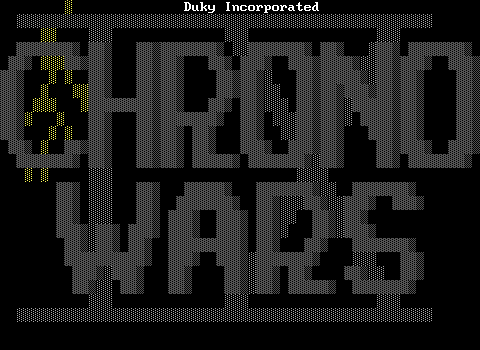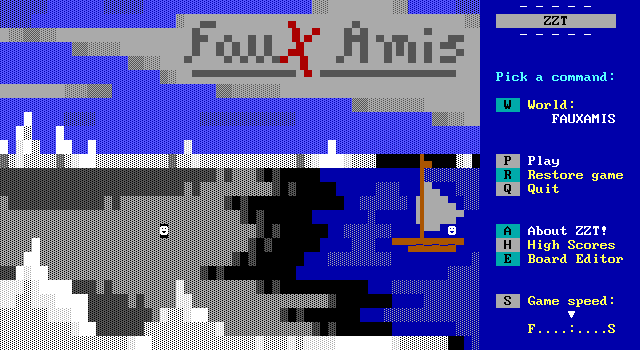
Originally released in 2018, when the ZZT community was finally on the rebound and excited to have more than a double digit number of releases for the year, Rabbitboot's Faux Amis delighted all who played. The game stood out from the rest of the year's offerings by feeling like a good old fashioned ZZT adventure in a strange land without sparing consideration for players' time and energy to be expected from modern games, ZZT or otherwise. The result is a game that hearkens back to many classics of old, that also feels quite fresh and different from the rest. Faux Amis is a real gem of a game, that has learned from ZZT's history what works, what doesn't, and focuses on creating a tightly-packed adventure full of some unique (and fiendish!) puzzle elements, with what was then perhaps the best sense of detail in a ZZT world around at the time.
The story is one that has been seen many times in ZZT before. An unexpected turn of events leaves the nameless protagonist stuck in a strange land with no clear means of returning back home. Long time players of ZZT worlds may have their minds quickly jump to titles such as Best of ZZT Part I: The Secret of Headhunter Isle, The Secret of Cannibal Island; or later releases like Pop and Pepper Bolette. It's a formula nearly as old as ZZT itself, but this is no nostalgic throwback to the distant past. Faux Amis is a far more contemporary take that brings the style into its next evolution.

Your ship has been caught in a rogue whirlpool and sank just off the shore of an island consisting of a tiny town full of friendly faces that can use the help of a freshly-drafted adventurer such as yourself. There are no attacks by wild ruffians to be found here, nor will you be clearing rats out of anybody's basement. The tasks are a bit more mundane than that. Help farmer Amy out with her crops. Do some repairs on the old mill. Doctor Amy seems to have misplaced her bag. The town's undertaker, Amy, can use a hand getting some heavy tombstones onto her workbench. Amy the shopkeeper is glad to sell the player a new rifle or flashlight which may come in handy when doing these various odd jobs. Yes, this is one of the more tranquil towns I've ever seen in ZZT.
But then again, why are they all named Amy? Maybe there's something off about this place actually...
The player isn't helping out of altruism though, they're trying to earn some desperately needed gems. Amy explains to the player that it costs two hundred gems to purchase a ticket for the ferry, and time is of the essence. That ferry only arrives twice a year, and today just happens to be one of those days, with the next vessel not due for another five months. Making matters worse is the fact that the ferry will depart at noon, and it's six o'clock already. You better work fast.
That's a tall order however. While everyAmy is rich in spirit, their financial situations aren't all that much better than the player's. The odd jobs pay merely a pittance, of a gem or two each. Worse yet, gems aren't the only currency here on the island of Fowe. Time you thought was spent working for gems may actually have been time spent working for "Fowe Silver Dollars", a far less popular form of currency. Now "Fowe Gold Dollars", those can at least be converted to gems at the local pawn shop... as long as you can keep your transaction between you and Amy.
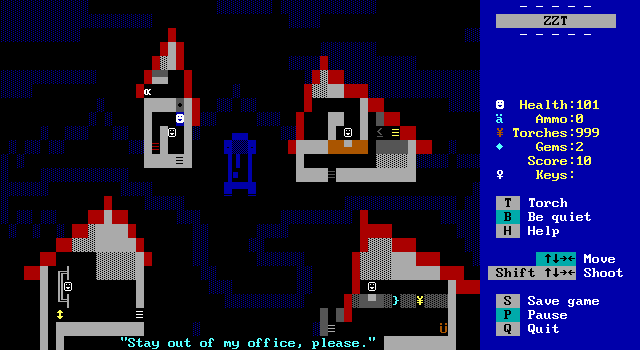
As the hours advance players will find themselves more desperate, and have their morals tested. The residents of Fowe island value their privacy. They will politely, yet firmly, ask the player to not indulge in adventuring stereotypes such as raiding their cabinets, pilfering their safes, rummaging through desk drawers, or snooping under mattresses. There are plenty of ZZT games that indulge in the trope that anything not bolted down belongs to the player. There are still others that subvert it, telling players no, they can't just walk into an empty house and grab whatever they can find. Rabbitboots takes the unique approach of testing the players' morality. When the residents run off to do something else and leave the player unattended, these previously restricted actions suddenly become available, but who knows for how long?
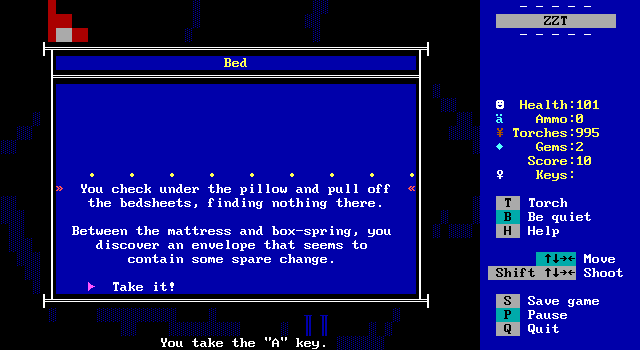
The only thing to stop you is the knowledge that you have been told not to do these things by your hosts, but it's your own personal conscience as you control the player that determines whether or not you'll respect their wishes. Is a bit of spare change worth your moral integrity? Perhaps you can resist the temptation, but then again, the clock is ticking...
Not literally of course, but far more than most. A unique aspect of Faux Amis that will quickly begin to influence your personal conduct is the game's clock. In the center of Town a large grandfather clock displays the hour prominently. This hour advances throughout the game as the player completes various tasks. The hour of day also exists for more than just to add a sense of anxiety, but to also expand the opportunities available to the player. The businesses have very strict hours of operation, so as the morning progresses some will open as others close. This helps add to the tension felt by the player on this otherwise laid-back feeling island.
Rabbitboots makes no attempt to disclose to the player what the rules of this world are. It's only through the player's exploration and actions that they'll discover whether or not they need to worry about finding enough gems in time or if it's all just some dressing to amp-up the experience. Is Faux Amis is the kind of game where the player needs to throw away their scruples and amass as many items and currencies as possible in order to achieve success? Is it making a statement about what desperate adventurers are willing do when their backs have been pressed against the wall? Or is this all just a sign of the times? The protagonist in Best of ZZT didn't think twice about looting gems out of an ancient pyramid. These days, where it's far more common for games to ask the players to consider what impact their actions are having on the residents of these worlds the ethics of it all are far more concerning.
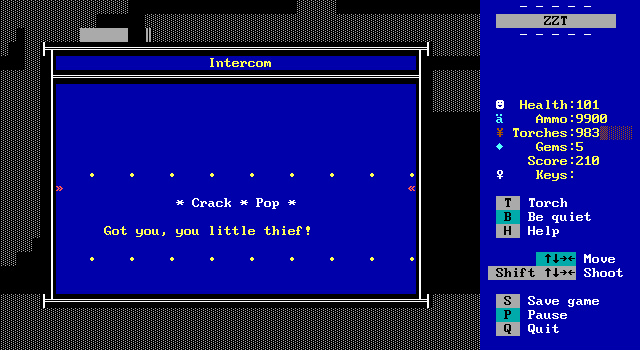
So when you happen to find a key to strange underground labyrinth and begin to hear voices telling you that you really shouldn't be here, are you the type to listen to them, or are you going to do whatever it takes to uncover all the secrets of Fowe Island all in the name of "adventure"?
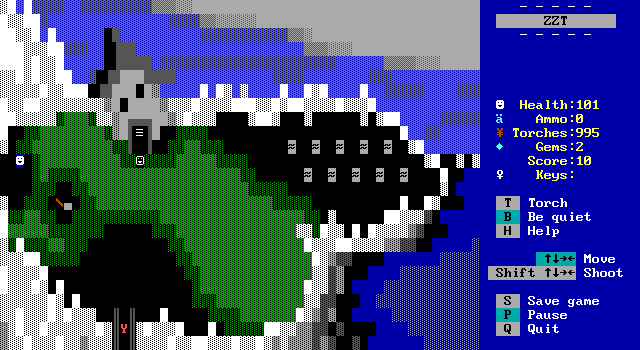
There is much more to Fowe island than what the Amys want you to see. Three gates line the southern portion of the island, labeled "A", "M", and "Y" and locked with corresponding keys. In order to peel off the surface and see what lies beneath, the player themselves will have to delve beneath the surface and into an far stranger world underground. The quaint little village is only the beginning, as the simple locked gates are just the first bits of security. Soon the player will find themselves presented with some much more complex technology in the form of a numeric keypad to input a password. Something is amiss.
For as much of the game as is about helping the residents, none of it feels "right". Everyone is named Amy, everyone seems to have something or other locked up in their homes, and the prices at the shop in town will you leave you wondering if you're going to be stuck here forever. When you then begin to wander some halls that aren't well-lit, but well-darkened, the atmosphere of the game goes from unsettling to outright creepy. Don't be too afraid, Faux Amis has its secrets and all, but this is not a horror game by any means. It presents itself as an adventure, and you should trust Rabbitboots there. For not long after you'll discover the game's true strength: puzzles.
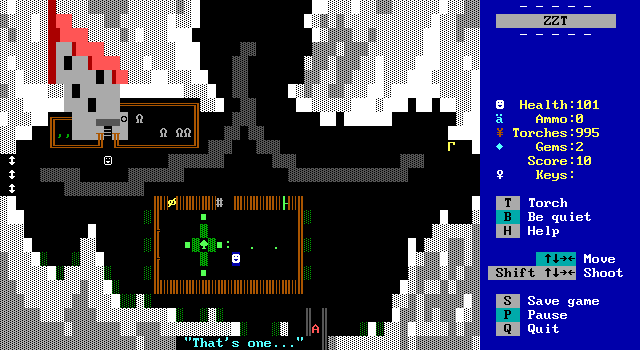
The puzzle aspects of the game aren't entirely kept to the underground section of the game. One of the first tasks the player will be permitted to do is to help farmer Amy grow some crops. This is done by surrounding saplings with boulders which will cause them to sprout, pushing the boulders away as the tree grows by surrounding itself with forest tiles. Then the player will have to use a convenient machine that turns forests into more boulders allowing the other trees to get the same treatment.
"Put boulder here" is merely Sokoban of course, and ZZT is no stranger when it comes to this type of puzzle design, which is featured as a component of games like Xod as well as the entire gameplay mechanic of Nadir's <untitled>. Let's be real though, by 2018 the world has shoved enough blocks in enough warehouses. Rabbitboots is quite aware of this, solving the issue of the same-old puzzle design with the twist of the forest tiles. Instead of just pushing boulders, the player also has to consider the limited amount of room they have. Thought must be put into which forest tiles should be "trimmed" by walking over them and which should be transformed into boulders. The field is tiny enough that upon sprouting some of the boulders used in the process will be pushed up against walls, rendering them unable to be used again.
This is the first puzzle and I'm admittedly over hyping it. It's not much of a brain teaser, but it is a gentle introduction to Rabbitboots's notable skill with coming up with some creative takes on previously seen puzzles in ZZT before getting into the thick of it with the underground puzzles which have the benefit of being both more complex as well as more original.
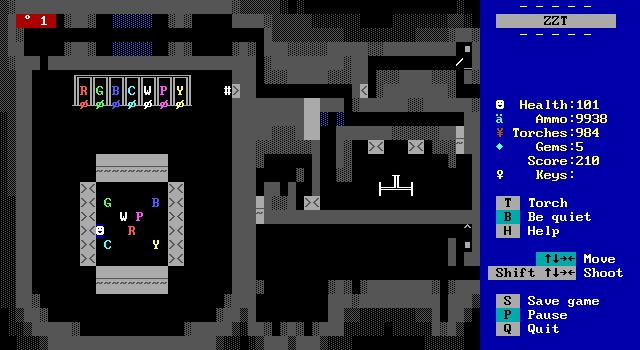
This is where the game's (suspected) influences feel less like ZZT's earliest days and more like the post-STK era of the 90s. You're (hopefully) all alone down there, with nothing to do but think your way through a variety of obstacles. To me at least, the approach taken down here is very reminiscent in particular to myth's classic puzzle game and fellow featured world Winter. As in Winter, there are no explanations given on what you need to do in any given room, relying entirely our your own brain to figure out what various switches and levers do, and how you're supposed to work with various components to open up access to the next room.
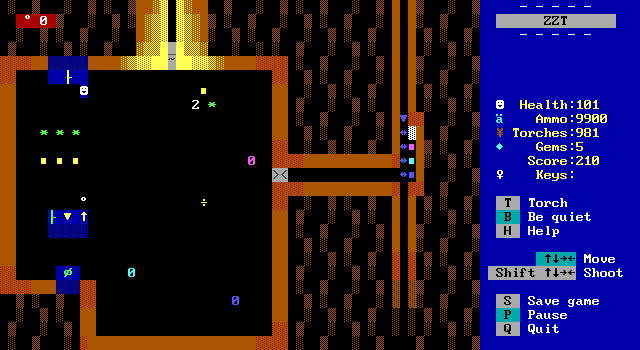
While Winter's puzzles don't take too long to come to terms with, Rabbitboots does not hold back. These puzzles are some of the most challenging I've seen in ZZT. Barjesse, made famous for his triumph of ZZT puzzle design with Nightmare gets a run for his money here. Depending on your own preferences, this may be Faux Amis's greatest success, or it's most scathing indictment. Over on the Discord, I've definitely witnessed folks who were very unhappy with how obtuse some of these can feel, and I can certainly share sympathies. As I was revisiting the game, there were a handful of instances where I felt utterly clueless as to what needed to be done, and really didn't want to spend my entire afternoon unable to get through the entire adventure. The demands placed on the player here are considerably greater than Ana, a game of similar vintage that goes all-out on puzzles for gameplay, but with more established and basic designs that make them more approachable rather than daunting. Faux Amis, if you're not accepting any outside help, isn't for the faint of heart.
The puzzles may not offer any assistance to players, but Rabbitboots is still willing to do so. The game does come with a complete walkthrough providing step by step instructions for those truly stumped. For a lighter approach, scroll the document slowly, as each puzzle not only comes with a solution, but an explanation of how to interact with it and what the goal is. This is a much better compromise to the game's difficulty that was enough in the two moments I felt hopeless to be able to get a jump-start on progress and ultimately come up with proper solutions myself. Following the guide to the letter will certainly let you see it to the end, at the cost of missing out on some of the most unique aspects of the game.
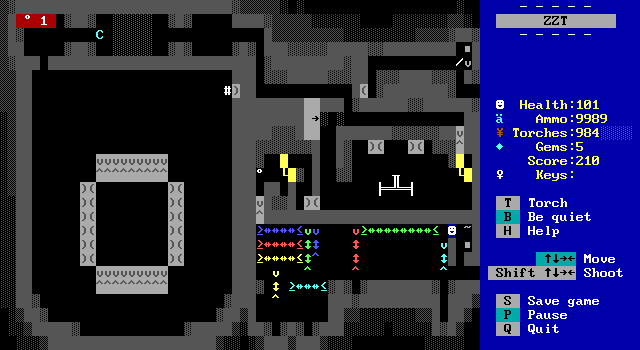
Not all the puzzles are giant set-pieces. Many of them are the sort of ideas that slightly build on what ZZT offers. For example, you won't go around pushing any sliders yourself, but you will touch objects that then push them for you. The distinction may seem pointless at first, a north/south slider can still only move north or south after all. The nuance comes from the new ability to touch these objects from the side which has a huge impact on what moves are valid at any given point and does dramatically change the design of such a puzzle compared to one relying entirely on ZZT's built-in puzzle pieces. It's familiar, but not too familiar.
These kind of obstacles are really just a warm-up. It's the larger set-pieces which make Faux Amis one of the best puzzle games for ZZT around. Actually going into detail is a challenge of it own, as I certainly don't want to ruin the satisfaction of figuring them out for yourself. Without divulging too much, expect to find yourself arranging objects that bloom into shapes to fill containers, to push and pivot angled blocks to create a safe passage through a dangerous space, to find a way to make one bullet hit three targets, to shoot several targets simultaneously, to help objects which jump at varying heights to ascend a tower, and even to do a little programming so that an object can successfully navigate a maze.
There's quite a lot in the underground, and each chamber is quite intricate. The thought put into these puzzles is really the star here. They are frequently quite complicated works of ZZT-OOP that are far more robust than the ZZT puzzles of yore. As a modern ZZT world, great pains have been taken to ensure that these puzzle pieces won't be broken, whether by overeager players acting too quickly, or merely trying something the author hadn't considered. For the former, Rabbitboots has done some impressive work. These are the sort of puzzles that while they could have been pulled off years ago, I suspect the experience would have been much worse. For the latter, well, that's the difference in commitment to play-testing nowadays as opposed to the far more lax standards of the past. It's not perfect, this is version 1.02 after all, and while you'll surely be saving at the start of each puzzle, it's unlikely you'll actually run into a way to actually break things[1].
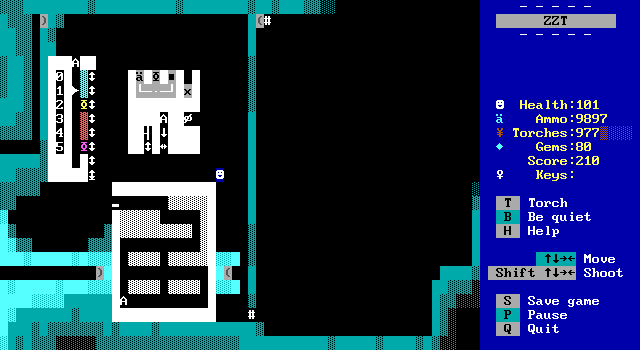
If anything, your puzzle progress isn't going to be halted by bugs, but by your own mistakes. We're dealing with a post-Ana world here, so there's nothing to worry about there. Every puzzle which could necessitate one will have a dedicated reset button: . Be sure to commit it to memory! The lack of text to accompany these puzzles means that I definitely pressed it once or twice mistaking it for a mysterious new button yet to be pressed and had to start over when I didn't actually want or need to. Luckily, the length of the puzzles comes from the time the player spends thinking and not the time executing your solution. Lost progress is rapidly recovered, but bending the unstated no-text rule to write "RESET?" and presenting a prompt would have been appreciated here. It's also worth noting that even the most complicated puzzles seem to reset themselves fairly quickly. Recall the intricacies in Town of ZZT Remix's Rube Machine taking so long that it was faster to quit and restore a saved game rather than waiting for it to finish resetting. Here the buttons are much more favorable to your time making the buttons a welcome addition.
The care for the player (mis-presses aside) extends beyond merely allowing for a reset rather than a reload. Undoubtedly one of the most common mistake across all ZZT puzzles is pushing a boulder against a wall and having no way to move it perpendicular to the wall afterwards. Rabbitboots eschews boulders when not using that property as a part of the puzzle's design, and instead opts for objects that allow the player to instead "pull" when they're pushed against a wall. It saves a lot of headaches and lets the player focus on implementing their solution rather than having to make safety saves as a reload is still less costly in time than the combination of resetting a puzzle and then redoing what you had previously done before making a mistake.
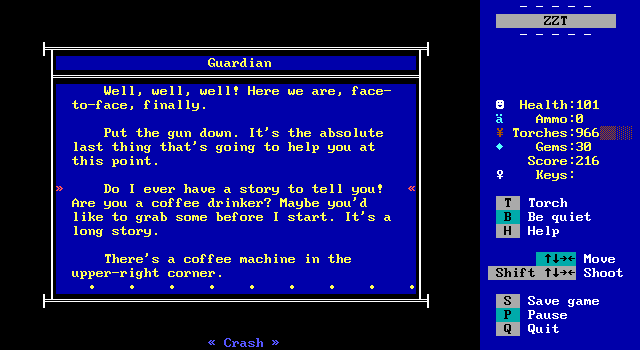
One shared attribute between the overworld and underground segments is the slow pacing. Yes, the game is on a timer and in that sense this is a game about beating the clock while your goal of getting back to the mainland is still an option. However, since the clock only advances after specific events, whatever the player happens to be working on can be taken quite slowly. This changes for the finale, which is one of the highlights of the game. It should go without saying that I can't speak too freely of what happens come noontime, whether the player has the gems or not, but it does an excellent job giving the eccentric characters some much needed explanation. Or at least, as good an explanation as such characters could get. The final minutes do see the player running around Fowe in order to beat the odds and just go home already. It's genuinely one of the more impressive climaxes to a ZZT world I've experienced, and lets me say with confidence that even players that do struggle with the puzzles and end up leaning on the included guide to get through it will still recognize the game as one well worth the time spent playing. Again, not to give too much away, but... just consider what you do and say around Amy, okay?
The characters and puzzles are more than enough to make Faux Amis an iconic title and unforgettable adventure that represents a high watermark for the type of "silly ZZT game worlds" Tim Sweeney likely expected fans of his program to create. In many ways the game feels old-fashioned, in the best way, letting experienced players once more get sucked into the strange designs that emerge when you give inexperienced programmers the tools to make little text mode games. Rabbitboots of course has a much longer history with ZZT than the newly credit name in the text file would lead one to believe[2]. In the z2 era when worlds were published devoid of information like dates and screenshots, the bulk of what's been said so far could lead to some wildly varied interpretations of what the game actually looks like. Perhaps the programming might seem a bit too ambitious for a game from ZZT's infancy, but the vast majority would fit in just fine with cheery colorful worlds of the olden days.
This is a world from 2018 though, so while the setting and story feel like they'd be right at home in a FILE_ID.DIZ file, the look of the game is a lot more modern, and this is still another way in which Rabbitboots brings the game into the modern era. Faux Amis is a sight to behold, but not in the expected way of detailed shading. What sets this world apart is both the quantity and quality of animation seen throughout.
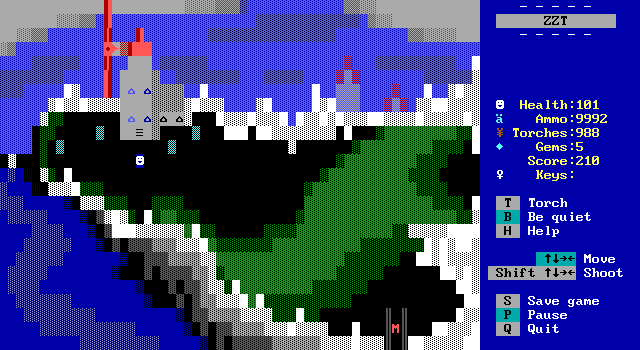
This is most apparent in how unlike any other ZZT game I've ever seen, it feels like there's actually weather. There are no rigid sunset gradients or matte painting-esque backgrounds of unmoving blue skies to be found here. Nature is very much alive here, as is the rest of the world. Games like Banana Quest impressed back in the day with animated coastlines, but Rabbitboots takes things considerably further. Yes the coastlines change in size with the ebbing tides. That's just the baseline. Waves can be seen not just on the coast but in the ocean's waters. Clouds shift slightly in the skies above. Trees sway in the breeze. Fixing the stuck gears of the windmill will cause machinery to whirr, and the blades to turn. It's a cloudy and windy day on Faux Island. It looks like there's a storm about to roll in.
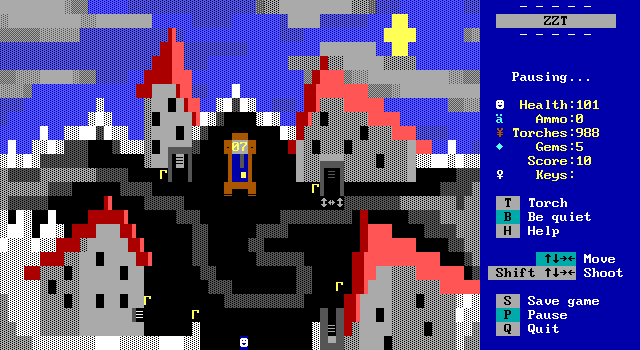
Even the passage of time as events unfold will trigger visual flourishes. The sun, no longer your typical yellow circle tucked away in the corner, slowly moves across the sky as the hours of the grandfather clock in the center of town (with animated pendulum of course) increase. The movement of the sun in turn causes the portions of the buildings' roofs to change in their color intensity as some portions become bathed in light while others rest in shadow. Not only does this look fantastic, but it really sells the idea that time is passing beyond simply changing to read and calling it a day.
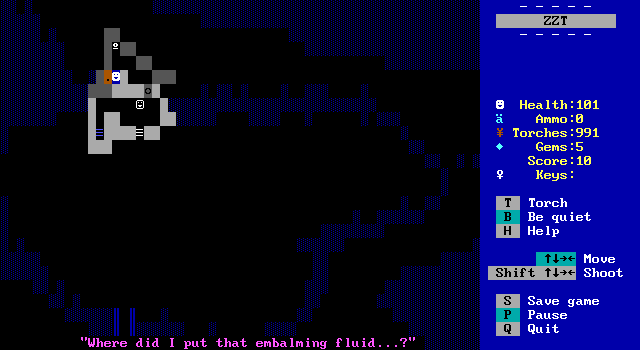
More courtesies to help the world feel real include taking on the challenge of having the interiors of buildings match the shape of their exteriors. For once a home in ZZT isn't an apologetic TARDIS, larger on the inside than the outside. Or, equally popular, large building that take up most of a board that are scaled down once inside to keep the player from wandering. Rabbitboots certainly didn't have to do this, the lack of consistency is expected in ZZT games and in the case of smaller interiors versus giant empty rooms, can even be preferable. Making this work is really going the extra mile and allows the background of these interior scenes to simply dim the lights while retaining the outline of the outer world.
Not even the basic bits of standard ZZT techniques are neglected. Simple arrangements of sliders are used to block off paths the player doesn't yet have access to. Exactly the sort of thing that most ZZTers would instantly erase with a simple #change sliderew empty. Instead these too are subject to brief animations switching between slider type before vanishing. I don't think this is something new to Faux Amis, but it draws your eye over to the flashing blocks and makes sure you notice them, something far preferable to entering a board and having them vanish instantly. Gone is the burden being placed on the player to remember which building it was that was closed earlier. The eye-catching flickering makes it clear that something new is available to be explored.
All of this deals with the detail of the island's surface. Spelunkers have no need to fret though as there are some wonderful effects underground as well. Rabbitboots makes extensive use of (*sigh*) the Kangaroo Effect[3]. This allows for darkness that isn't just "darkness" and is used to really create an atmosphere of awe and mystery with background elements that form strange structures and shapes which often vanish when the player gets close. Combine this with the labyrinthine layout of the underground and Rabbitboots manages to take what should be the dullest part of the game, and keep the player engaged, wondering whether a shape is real or not, and how on earth they're supposed to get over there in the first place.
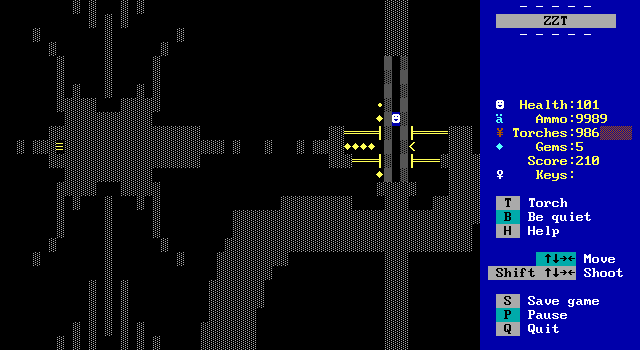
In addition to creating confusion, the mix of ZZT's darkness and solid black creates for some striking looking minimalist boards. ZZT's darkness normally obscures everything. Using black highlights helps make it clear to players that they're descending down a narrow vertical shaft deeper into the earth and fuels the imagination as to what it all means. It's a very rare thing in ZZT to praise the appearance of a dark room, so don't be surprised if you find yourself spending a moment take in the scenery, or at least what's hinted of it. Try to keep a move on though because when the darkness suddenly begins to move, you might not feel comfortable being overtaken by it.
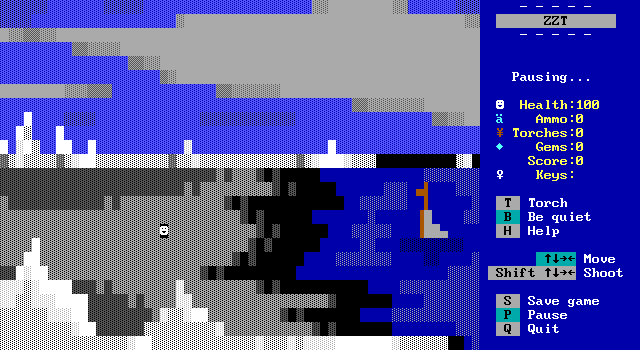
And somehow I got through discussing all this without talking about how the game opens with a very impressive animation of the player's ship sinking into the water with bubbles rising to the surface! This is the player's introduction to the game and immediately makes it clear that this is going to be a very polished creation.
Those who find themselves impressed by the visual techniques used throughout Faux Amis should be sure to check out Rabbitboot's Doodads 2018 which offers demonstrations of several innovative visual effects including those used by Faux Amis. They're deceptively simple and definitely worth having in your back pocket when trying to spice up your own ZZT boards.
The download also includes a few goodies too! For ZZT itself you get the main game file, its beta release, a file of scrapped concepts for the game and some other projects that never went anywhere. As mentioned previously when discussing puzzles, a full walkthrough is included as well that contains both explanations of the goals and mechanics of each puzzle along with "just do this" solutions.
There's also a devlog available on Glorious Trainwrecks that gives a lot of insight as to just how much the game changed from its initial design. There's a lot worth reading after you've played to see what Faux Amis could have been. Actually documenting the process of creating a ZZT game, especially when so much of the game's content was up in the air still remains a bit of a rarity. It's more work and makes the sting of an unfinished project hit that much harder. Kudos to Rabbitboots for being so committed here.
Faux Amis shows us just how capable ZZT is at creating compelling experiences. Not all ZZT games need to try and be the best one ever made. Faux Amis is incredibly comfortable with what is is: a highly polished old-school adventure with a strong commitment to the little touches. It grabs players' attention and thrusts them into an unusual setting with a light touch of nostalgia that only serves as seasoning for the experienced.
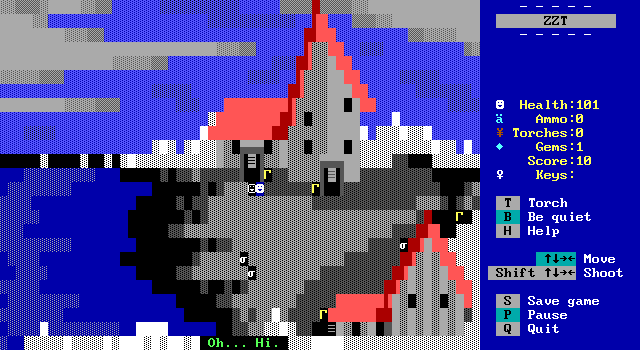
For newcomers, Faux Amis remains an excellent choice to see what modern ZZT games strive to be, maintaining the spirit of old while discarding the design baggage that older worlds often suffer from today. Its puzzles are challenging in just the right way, with a guide to help those who don't have the time or patience to really delve into them. The moral dilemmas presented to the player with regards to their actions and the island's guarded approach towards adventuring types does a fantastic job of helping the world's occupants feel alive and give the player moments of hesitation before they commit a misdeed in the name of heroism. At the same time, the ethics aren't the focus of the game's story so if you want to just loot everything that isn't nailed down, more power to you. I mean, who's going to find out anyway?
Experienced players can appreciate the subtle nods to well-regarded worlds of the past without fear that this is just a rehash of the ZZT adventures you've already played. Faux Amis feels timeless in just how well it blends the old and the new. It's hard to imagine an era when this game wouldn't have drawn attention, and I'm quite glad that it happened to come out not when ZZT was on life support, but when it was finally on its way to recovery. Now, rather than being a fondly remembered title of the distant past, Faux Amis can exist as an example of what it means to make a ZZT world today. It's a game that after playing, not only will you be satisfied fully by the experience, but leave you with that itch to create something yourself. It serves as a reminder that no matter how long you've been using ZZT, that you don't need to create a multi-file epic. Just one brief afternoon of adventure can be more than enough to create memories for a lifetime.
[1] I actually did run into a bug, albeit one in my favor. A certain puzzle's reset button caused some objects to not reset to their starting position allowing me to have a fresh start with my solution, but starting with the puzzle half solved. As I found out though, pressing the button a second time did get these objects to return to their origin and properly reset.)
[2] The previous identity of Rabbitboots falls under "open secret", or at least did back in 2018 when I first played the game. If you're aware of their past works, it's no surprise Faux Amis turned out as well as it did. If you don't, well, maybe you'll happen to stumble into something that lets you connect the dots some day. Unless I hear otherwise, consider my lips super locked.
[3] I really did play myself with this one: http://zzt.org/fora/viewtopic.php?p=52168#p52168.

